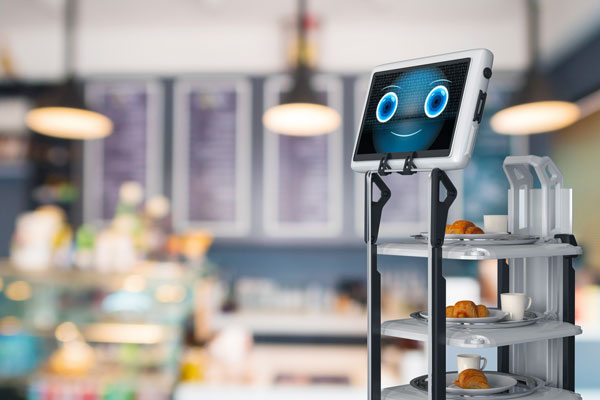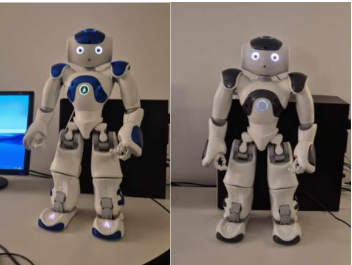Achim, A. M., Thibaudeau, É., Haesebaert, F., Parent, C., Cellard, C., & Cayouette, A. (s. d.). La cognition sociale : Construits, evaluation et pertinence clinique. REVUE DE NEUROPSYCHOLOGIE, 25.
Araguas, A. (2022). Interagir avec des robots sociaux : Une approche pluridisciplinaire chez l’enfant et l’oiseau. Thèse de doctorat de Ethologie et cognition comparées à l’Université Paris Nanterre. https://theses.hal.science/tel-03817167.
Arita, A., Hiraki, K., Kanda, T., & Ishiguro, H. (2005). Can we talk to robots? Ten-month-old infants expected interactive humanoid robots to be talked to by persons. Cognition, 95(3), B49-B57. https://doi.org/10.1016/j.cognition.2004.08.001
Baron-Cohen, S. (1997). Hey ! It was just a joke ! Understanding propositions and propositional attitudes by normally developing children and children with autism. The Israel Journal of Psychiatry and Related Sciences, 34(3), 174-178.
Baron-Cohen, S., Leslie, A. M., & Frith, U. (1985). Does the autistic child have a “theory of mind” ? Cognition, 21(1), 37-46. https://doi.org/10.1016/0010-0277(85)90022-8 Beaudoin, C., & Beauchamp, M. H. (2020). Social cognition. In Handbook of Clinical Neurology (Vol. 173, p. 255-264). Elsevier. https://doi.org/10.1016/B978-0-444-64150-2.00022-8
Belpaeme, T., Baxter, P. E., Read, R., Wood, R., Cuayáhuitl, H., Kiefer, B., Racioppa, S.,Kruijff-Korbayová, I., Athanasopoulos, G., Enescu, V., Looije, R., Neerincx, M., Demiris, Y.,Ros-Espinoza, R., Beck, A., Cañamero, L., Hiolle, A., Lewis, M., Baroni, I., … Humbert, R. (2013). Multimodal Child-Robot Interaction : Building Social Bonds. Journal of Human-Robot Interaction, 1(2), 33-53. https://doi.org/10.5898/JHRI.1.2.Belpaeme
Duval, C., Piolino, P., Bejanin, A., Laisney, M., Eustache, F., & Desgranges, B. (2011). La théorie de l’esprit : Aspects conceptuels, évaluation et effets de l’âge. Revue de neuropsychologie, 3(1), 41. https://doi.org/10.3917/rne.031.0041
Filippini, C., Cardone, D., Perpetuini, D., Chiarelli, A. M., Petitto, L. A., & Merla, A. (2020). Assessment of autonomic response in 6–12-month-old babies during the interaction with robot and avatar by means of thermal infrared imaging.
Filippini, C., & Merla, A. (2023). Systematic Review of Affective Computing Techniques for Infant Robot Interaction. International Journal of Social Robotics, 15(3), 393-409. https://doi.org/10.1007/s12369-023-00985-3
Flatebø, S., Tran, V. N.-N., Wang, C. E. A., & Bongo, L. A. (s. d.). Social robots in research on social and cognitive development in infants and toddlers : A scoping review. PLOS ONE. Guellaï, B., & Esseily, R. (2018). Psychologie du développement : Cours, méthodes, entraînement. Armand Colin.
Hoicka, E., & Akhtar, N. (2012). Early humour production : Early humour production. British Journal of Developmental Psychology, 30(4), 586-603. https://doi.org/10.1111/j.2044-835X.2011.02075.x
Jiang, T., Li, H., & Hou, Y. (2019). Cultural Differences in Humor Perception, Usage, and Implications. Frontiers in Psychology, 10, 123. https://doi.org/10.3389/fpsyg.2019.00123
Kanda, T., Miyashita, T., Osada, T., Haikawa, Y., & Ishiguro, H. (s. d.). Analysis of humanoid appearances in human-robot interaction.
Kim, Y., Hwang, J., Lim, S., Cho, M.-H., & Lee, S. (2023). Child–robot interaction : Designing robot mediation to facilitate friendship behaviors. Interactive Learning Environments, 1-14. https://doi.org/10.1080/10494820.2023.2194936
Kirby, R., Forlizzi, J., & Simmons, R. (2010). Affective social robots. Robotics and Autonomous Systems, 58(3), 322-332. https://doi.org/10.1016/j.robot.2009.09.015
Kozima, H. (s. d.). Un robot interactif comme média pour l’observation d’enfants : Technique du « Magicien d’Oz » dans le cadre de la thérapie de l’autisme.
Langer, A., Marshall, P. J., & Levy-Tzedek, S. (2023). Ethical considerations in child-robot interactions. Neuroscience & Biobehavioral Reviews, 151, 105230.https://doi.org/10.1016/j.neubiorev.2023.105230
Norimatsu, H., Takada, A., Negayama, K., Kimura, M. Solomiac, S. & Soucas, R. (2021).
Understanding and production of teasing in young children: Japanese-French comparison – from the analysis of interviews with parents of 0 to 6 year-old children. Oral communication in the symposium “Joking, Laughing, and Teasing: Their Relationship to Theory of Mind Development”.
The 32nd International Congress of Psychology (ICP). July 18-23, 2021, Prague, Czech Republic. Okumura, Y., Hattori, T., Fujita, S., & Kobayashi, T. (2023). A robot is watching me! : Five‐year‐old children care about their reputation after interaction with a social robot. Child Development, 94(4), 865-873. https://doi.org/10.1111/cdev.13903
Premack, D., & Woodruff, G. (1978). Does the chimpanzee have a theory of mind? Behavioral and Brain Sciences, 1(4), 515-526. https://doi.org/10.1017/S0140525X00076512
Reddy, V., & Mireault, G. (2015). Teasing and clowning in infancy. Current Biology, 25(1),R20-R23. https://doi.org/10.1016/j.cub.2014.09.021
Roesler, E., Manzey, D., & Onnasch, L. (2023). Embodiment Matters in Social HRI Research : Effectiveness of Anthropomorphism on Subjective and Objective Outcomes. ACM Transactions on Human-Robot Interaction, 12(1), 1-9. https://doi.org/10.1145/3555812
Rossi, L., Orsenigo, E., Bisagno, E., & Cadamuro, A. (2024). From learning machines to teaching robots. Interaction for educational purposes between the Social Robot NAO and children : A systematic review. 20(1).
Tielman, M., Neerincx, M., Meyer, J.-J., & Looije, R. (2014). Adaptive emotional expression in robot-child interaction. Proceedings of the 2014 ACM/IEEE International Conference on Human-Robot Interaction, 407-414. https://doi.org/10.1145/2559636.2559663
Wellman, H. M., & Liu, D. (2004). Scaling of Theory-of-Mind Tasks. Child Development, 75(2), 523-541. https://doi.org/10.1111/j.1467-8624.2004.00691.x
Woodward, A. (1998). Infants selectively encode the goal object of an actor’s reach. Cognition, 69(1), 1-34. https://doi.org/10.1016/S0010-0277(98)00058-4





